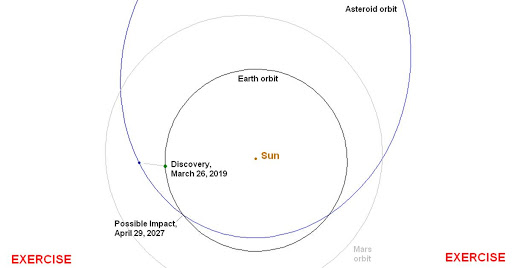Planetary defence
Yikes! Did NASA just dust New York?
No, they didn’t. Don’t worry. It was all an exercise. But it makes a fun read!
Recently NASA and JPL hosted a conference on planetary defence – against near-Earth objects, that is, not aliens. Part of the five-day conference was a simulation of the discovery of an object on a collision course with Earth. Each day, more information was presented, and experts were asked what the best course of action would be, including options to deflect or “disrupt” the asteroid. They also discussed what would be at risk, and how to manage and mitigate damage.
The hypothetical narrative that the experts were subjected to was this:
In March 2019, the asteroid is discovered, and is estimated to have an impact probability of 1 in 100. At this point, most of the effort is focused on determining the fine orbit, and the size and mass of the asteroid.
By July 2019, additional information has increased the probability of impact to 1 in 10. This is when the authorities start thinking about what can be done to shift the asteroid’s orbit. The choice is “deflect or disrupt” – “push or break up”. We’re starting to build spacecraft to go to the asteroid to look closer to determine mass, structure and porosity.
At the end of December 2021, the rendezvous missions had determined its size and mass, allowing a calculation of what would it take to shift it off course. A fleet of six “kinetic impact” craft, two of which carry nuclear warheads, are sent to deflect, and if necessary disrupt the asteroid.
On 3 September 2024, the impacts have deflected some of the asteroid, which has broken up. However, one piece, roughly 60 metres across is now headed for New York. In the scenario, it will strike the city on 19 April 2027, coming in at 70,000 km/h and having the destructive capacity of a 5-20 megatonne nuclear explosion. The question now is how to minimise the damage?
Here's their graphical simulation of the impact.

Comments
Post a Comment